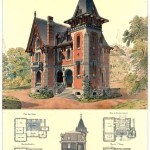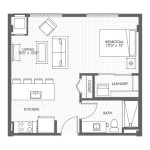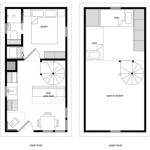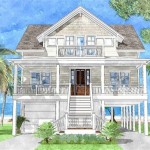House Plan: Five Bedrooms, Two Bathrooms
The house plan featuring five bedrooms and two bathrooms is a design archetype often sought by large families, multi-generational households, or individuals who require dedicated spaces for home offices, guest rooms, or hobbies. These types of floor plans prioritize functionality and spatial efficiency, balancing the need for private retreats with communal living areas. The configuration necessitates careful consideration of factors such as overall square footage, room dimensions, traffic flow, and the allocation of plumbing and electrical systems.
The appeal of a five-bedroom, two-bathroom house plan lies in its adaptability. It can accommodate a diverse range of living situations and evolving needs. As families grow or circumstances change, the additional bedrooms offer flexibility. The two bathrooms, while potentially serving a larger population, require strategic placement to minimize congestion and maximize accessibility for all occupants. The plan's suitability is also contingent on the lot size and orientation, as these factors influence the potential for natural light, outdoor living spaces, and overall aesthetic appeal.
Key Point 1: Spatial Organization and Flow
The success of a five-bedroom, two-bathroom house plan hinges on the effective organization of space. The arrangement of rooms should promote a seamless flow between living areas, bedrooms, and bathrooms, while simultaneously maintaining a degree of separation between private and public zones. A common approach is to group the bedrooms together in one wing of the house, creating a dedicated sleeping area. This minimizes noise transfer and provides a sense of privacy for occupants.
The living areas, including the living room, dining room, and kitchen, should be centrally located and interconnected. This fosters a sense of community and facilitates social interaction. Open-concept designs, where the kitchen flows seamlessly into the living room, are particularly popular for their ability to create a spacious and airy feel. However, careful consideration must be given to noise control in such designs. The placement of hallways and doorways plays a crucial role in directing traffic flow and minimizing congestion. Wide hallways and strategically placed doorways can help to prevent bottlenecks and ensure ease of movement throughout the house.
The location of the bathrooms is also a critical factor. A common configuration is to have one bathroom accessible from the hallway, serving the general needs of the household, and a second bathroom located en suite within the master bedroom, providing a private retreat for the homeowners. Alternatively, the two bathrooms can be positioned close to each other, simplifying plumbing and reducing construction costs. Regardless of the configuration, the bathrooms should be easily accessible from all bedrooms and living areas.
Furthermore, the design should consider the placement of utility spaces such as the laundry room and storage areas. These spaces should be conveniently located yet discreetly tucked away from the main living areas. A well-designed mudroom, located near the entryway, can help to keep the house clean and organized by providing a designated space for shoes, coats, and other outdoor gear.
Key Point 2: Bedroom Dimensions and Functionality
The dimensions of the bedrooms in a five-bedroom house plan are crucial to their functionality and comfort. The master bedroom, typically the largest of the five, should be generously sized to accommodate a king-size bed, dressers, and potentially a sitting area. En suite bathrooms and walk-in closets are common features of master bedrooms, adding to their appeal and functionality.
The remaining four bedrooms may be smaller in size, but should still be adequately proportioned to accommodate a twin or full-size bed, a desk, and a dresser. The dimensions of the bedrooms should also take into account the potential needs of future occupants. For example, if the house is intended for a growing family, the bedrooms should be large enough to accommodate children of different ages.
Beyond the basic dimensions, the design should also consider the placement of windows and closets. Windows should be strategically located to maximize natural light and ventilation. Closets should be adequately sized to provide ample storage space for clothing and personal belongings. Built-in shelving and organizers can further enhance the functionality of the closets.
Furthermore, the bedrooms can be designed to serve multiple functions. A bedroom can be easily converted into a home office, a guest room, or a hobby room, depending on the needs of the occupants. The incorporation of flexible furniture and modular storage systems can further enhance the adaptability of the bedrooms.
Key Point 3: Bathroom Design and Accessibility
The design of the two bathrooms in a five-bedroom house plan should prioritize functionality, accessibility, and aesthetics. The layout of the bathrooms should be efficient, maximizing the use of available space. The placement of fixtures, such as the toilet, sink, and shower or bathtub, should be carefully considered to ensure ease of use and accessibility.
The materials used in the bathrooms should be durable, water-resistant, and easy to clean. Tile is a popular choice for flooring and shower walls due to its durability and water resistance. The selection of fixtures and finishes should complement the overall aesthetic of the house. A variety of styles and options are available, ranging from traditional to contemporary.
Accessibility is a crucial consideration in bathroom design, particularly if the house is intended for occupants with mobility limitations. Grab bars can be installed in the shower and around the toilet to provide support. Walk-in showers and comfort-height toilets can also enhance accessibility. The doorways to the bathrooms should be wide enough to accommodate wheelchairs or walkers.
Furthermore, the bathrooms can be designed to incorporate energy-efficient features, such as low-flow toilets, showerheads, and faucets. These features can help to reduce water consumption and lower utility bills. Natural lighting can also be incorporated into the bathroom design to reduce the need for artificial lighting.
The ventilation system in the bathrooms is also important to consider. A properly functioning exhaust fan can help to remove moisture and prevent the growth of mold and mildew. The size of the exhaust fan should be appropriate for the size of the bathroom.
The layout of the bathrooms can vary depending on the overall design of the house. A common configuration is to have a full bathroom with a toilet, sink, shower, and bathtub. Another configuration is to have a separate toilet room and shower room, which can improve privacy and efficiency.
In addition to the basic fixtures, the bathrooms can also be designed to include additional amenities, such as a vanity with ample storage space, a linen closet, and a heated towel rack. These amenities can enhance the comfort and convenience of the bathrooms.
Ultimately, the design of the two bathrooms in a five-bedroom house plan should be tailored to the specific needs and preferences of the occupants. Careful consideration should be given to functionality, accessibility, aesthetics, and energy efficiency.
Beyond these key points, various architectural styles can be adapted to a five-bedroom, two-bathroom house plan. Ranch-style homes offer a single-story layout, making them accessible for all ages. Two-story designs maximize square footage on smaller lots, while Craftsman-style homes emphasize natural materials and handcrafted details. Regardless of the architectural style, the underlying principles of spatial organization, bedroom dimensions, and bathroom design remain crucial to creating a functional and comfortable living space.
The selection of building materials also significantly impacts the cost and longevity of the house. Durable roofing materials, energy-efficient windows, and quality insulation are essential for protecting the house from the elements and minimizing energy consumption. Interior finishes, such as flooring, paint, and cabinetry, contribute to the overall aesthetic appeal and can also affect the long-term maintenance requirements.
In conclusion, a well-designed five-bedroom, two-bathroom house plan is a valuable asset for accommodating large families or individuals with diverse needs. By carefully considering spatial organization, bedroom dimensions, and bathroom design, it is possible to create a functional, comfortable, and aesthetically pleasing living space that will serve its occupants for years to come.

5 Bedroom Double Y House Plans

Traditional Style 5 Bedroom House Plan

5 Bedroom House Plan With 2 Story Family Room 710063btz Architectural Designs Plans

5 Bedroom House Plans Monster

5 Bedroom Open Concept House Plans Blog Eplans Com

Big Five Bedroom House Plans Blog Dreamhomesource Com

Spacious And Stylish 5 Bedroom Home 4 457 Sq Ft

Room To Grow 5 Bedroom House Plans Houseplans Blog Com

5 Bedroom Home Designs Fowler Homes

Million Dollar Large Luxury House Floor Plans Designs 2 Story 6 Bedroom Houses Two Y
Related Posts








